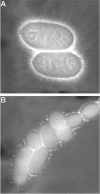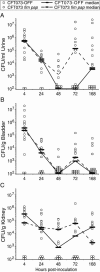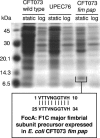Coordinate expression of fimbriae in uropathogenic Escherichia coli
- PMID: 16239562
- PMCID: PMC1273908
- DOI: 10.1128/IAI.73.11.7588-7596.2005
Coordinate expression of fimbriae in uropathogenic Escherichia coli
Abstract
Uropathogenic Escherichia coli is the most common etiological agent of urinary tract infections. Bacteria can often express multiple adhesins during infection in order to favor attachment to specific niches within the urinary tract. We have recently demonstrated that type 1 fimbria, a phase-variable virulence factor involved in adherence, was the most highly expressed adhesin during urinary tract infection. Here, we examine whether the expression of type 1 fimbriae can affect the expression of other adhesins. Type 1 fimbrial phase-locked mutants of E. coli strain CFT073, which harbors genes for numerous adhesins, were employed in this study. CFT073-specific DNA microarray analysis of these strains demonstrates that the expression of type 1 fimbriae coordinately affects the expression of P fimbriae in an inverse manner. This represents evidence for direct communication between genes relating to pathogenesis, perhaps to aid the sequential occupation of different urinary tract tissues. While the role of type 1 fimbriae during infection has been clear, the role of P fimbriae must be further defined to assert the relevance of coordinated regulation in vivo. Therefore, we examined the ability of P fimbrial isogenic mutants, constructed in a type 1 fimbrial-negative background, to compete in the murine urinary tract over a period of 168 h. No differences in the colonization of these mutants were observed. However, comparison of these results with previous studies suggests that inversely coordinated expression of adhesin gene clusters does occur in vivo. Interestingly, the mutant that was incapable of expressing either type 1 or P fimbriae compensated by synthesizing F1C fimbriae.
Figures





Similar articles
-
Multiple genes repress motility in uropathogenic Escherichia coli constitutively expressing type 1 fimbriae.J Bacteriol. 2008 May;190(10):3747-56. doi: 10.1128/JB.01870-07. Epub 2008 Mar 21. J Bacteriol. 2008. PMID: 18359812 Free PMC article.
-
yqhG Contributes to Oxidative Stress Resistance and Virulence of Uropathogenic Escherichia coli and Identification of Other Genes Altering Expression of Type 1 Fimbriae.Front Cell Infect Microbiol. 2019 Aug 29;9:312. doi: 10.3389/fcimb.2019.00312. eCollection 2019. Front Cell Infect Microbiol. 2019. PMID: 31555608 Free PMC article.
-
Fimbrial profiles predict virulence of uropathogenic Escherichia coli strains: contribution of ygi and yad fimbriae.Infect Immun. 2011 Dec;79(12):4753-63. doi: 10.1128/IAI.05621-11. Epub 2011 Sep 12. Infect Immun. 2011. PMID: 21911462 Free PMC article.
-
Classical chaperone-usher (CU) adhesive fimbriome: uropathogenic Escherichia coli (UPEC) and urinary tract infections (UTIs).Folia Microbiol (Praha). 2020 Feb;65(1):45-65. doi: 10.1007/s12223-019-00719-x. Epub 2019 Jun 5. Folia Microbiol (Praha). 2020. PMID: 31165977 Review.
-
F4 fimbriae expressed by porcine enterotoxigenic Escherichia coli, an example of an eccentric fimbrial system?J Mol Microbiol Biotechnol. 2004;7(4):155-69. doi: 10.1159/000079825. J Mol Microbiol Biotechnol. 2004. PMID: 15383714 Review.
Cited by
-
Plasmids shape the diverse accessory resistomes of Escherichia coli ST131.Access Microbiol. 2020 Nov 18;3(1):acmi000179. doi: 10.1099/acmi.0.000179. eCollection 2021. Access Microbiol. 2020. PMID: 33997610 Free PMC article.
-
SIMPLE approach for isolating mutants expressing fimbriae.Appl Environ Microbiol. 2007 Jul;73(14):4455-62. doi: 10.1128/AEM.00148-07. Epub 2007 May 25. Appl Environ Microbiol. 2007. PMID: 17526787 Free PMC article.
-
Adaptive strategies of uropathogenic Escherichia coli CFT073: from growth in lab media to virulence during host cell adhesion.Int Microbiol. 2022 Aug;25(3):481-494. doi: 10.1007/s10123-022-00235-y. Epub 2022 Feb 2. Int Microbiol. 2022. PMID: 35106679
-
Temporal Regulation of fim Genes in Uropathogenic Escherichia coli during Infection of the Murine Urinary Tract.J Pathog. 2017;2017:8694356. doi: 10.1155/2017/8694356. Epub 2017 Dec 27. J Pathog. 2017. PMID: 29445547 Free PMC article.
-
Phenotypic Assays to Determine Virulence Factors of Uropathogenic Escherichia coli (UPEC) Isolates and their Correlation with Antibiotic Resistance Pattern.Osong Public Health Res Perspect. 2015 Aug;6(4):261-8. doi: 10.1016/j.phrp.2015.08.002. Epub 2015 Aug 13. Osong Public Health Res Perspect. 2015. PMID: 26473094 Free PMC article.
References
-
- Allen, T. E., and B. O. Palsson. 2003. Sequence-based analysis of metabolic demands for protein synthesis in prokaryotes. J. Theor. Biol. 220:1-18. - PubMed
-
- Backhed, F., B. Alsen, N. Roche, J. Angstrom, A. von Euler, M. E. Breimer, B. Westerlund-Wikstrom, S. Teneberg, and A. Richter-Dahlfors. 2002. Identification of target tissue glycosphingolipid receptors for uropathogenic, F1C-fimbriated Escherichia coli and its role in mucosal inflammation. J. Biol. Chem. 277:18198-18205. - PubMed
-
- Bahrani-Mougeot, F. K., E. L. Buckles, C. V. Lockatell, J. R. Hebel, D. E. Johnson, C. M. Tang, and M. S. Donnenberg. 2002. Type 1 fimbriae and extracellular polysaccharides are preeminent uropathogenic Escherichia coli virulence determinants in the murine urinary tract. Mol. Microbiol. 45: 1079-1093. - PubMed
-
- Bahrani-Mougeot, F. K., S. Pancholi, M. Daoust, and M. S. Donnenberg. 2001. Identification of putative urovirulence genes by subtractive cloning. J. Infect. Dis. 183(Suppl. 1):S21-S23. - PubMed
Publication types
MeSH terms
Substances
Grants and funding
LinkOut - more resources
Full Text Sources
Other Literature Sources

